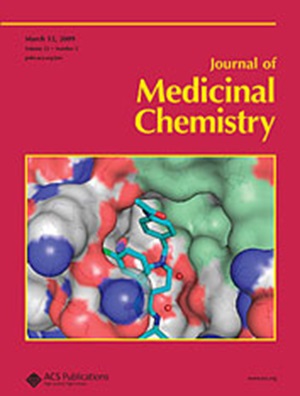Metalla-Aromatic Oligomers: Efficient Photocatalytic Activation for Phototherapy
IF 6.8
1区 医学
Q1 CHEMISTRY, MEDICINAL
引用次数: 0
Abstract
Monodisperse oligomers, positioned as intermediates between polymers and small molecules, retain certain reactivities of small molecules while simultaneously displaying the initial aggregation characteristics of the polymers. This distinctive structure bestows on them with significant potential for a wide range of applications. In this study, a series of carbolong osmium oligomers (Os1–Os4) and corresponding polymer were evaluated as photocatalysts. It was discovered that their molar absorption coefficients and reactive oxygen species generation rose with π-conjugation length, peaking at a polymerization degree of 4. Moreover, Os4 facilitates the photocatalytic oxidation of nicotinamide adenine dinucleotide (NADH) to its oxided form, NAD+. In vitro experiments demonstrated that Os4 had the strongest phototoxicity index in cells in hypoxic conditions, highlighting its potential efficacy in hypoxic tumor. Metabolomic analyses indicated that Os4 exerted its photocytotoxicity by disrupting purine metabolism. These insights will guide the future design of π-conjugated metal oligomers for advancing photocatalytic applications.

金属-芳香低聚物:光疗的高效光催化活化
单分散低聚物定位于聚合物和小分子之间的中间体,在保留小分子的一定反应活性的同时,又表现出聚合物的初始聚集特性。这种独特的结构赋予了它们广泛应用的巨大潜力。在本研究中,研究了一系列碳龙锇低聚物(Os1-Os4)和相应的聚合物作为光催化剂。发现它们的摩尔吸收系数和活性氧生成量随着π共轭长度的增加而增加,在聚合度为4时达到峰值。此外,Os4促进了烟酰胺腺嘌呤二核苷酸(NADH)的光催化氧化成其氧化形式NAD+。体外实验表明,Os4在缺氧条件下对细胞具有最强的光毒性指数,提示其在缺氧肿瘤中的潜在作用。代谢组学分析表明,Os4通过破坏嘌呤代谢发挥其光细胞毒性。这些见解将指导未来π共轭金属低聚物的设计,以推进光催化应用。
本文章由计算机程序翻译,如有差异,请以英文原文为准。
求助全文
约1分钟内获得全文
求助全文
来源期刊

Journal of Medicinal Chemistry
医学-医药化学
CiteScore
4.00
自引率
11.00%
发文量
804
审稿时长
1.9 months
期刊介绍:
The Journal of Medicinal Chemistry is a prestigious biweekly peer-reviewed publication that focuses on the multifaceted field of medicinal chemistry. Since its inception in 1959 as the Journal of Medicinal and Pharmaceutical Chemistry, it has evolved to become a cornerstone in the dissemination of research findings related to the design, synthesis, and development of therapeutic agents.
The Journal of Medicinal Chemistry is recognized for its significant impact in the scientific community, as evidenced by its 2022 impact factor of 7.3. This metric reflects the journal's influence and the importance of its content in shaping the future of drug discovery and development. The journal serves as a vital resource for chemists, pharmacologists, and other researchers interested in the molecular mechanisms of drug action and the optimization of therapeutic compounds.
 求助内容:
求助内容: 应助结果提醒方式:
应助结果提醒方式:


